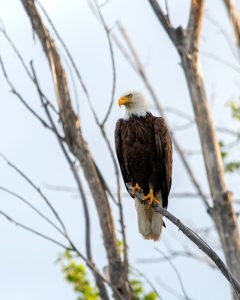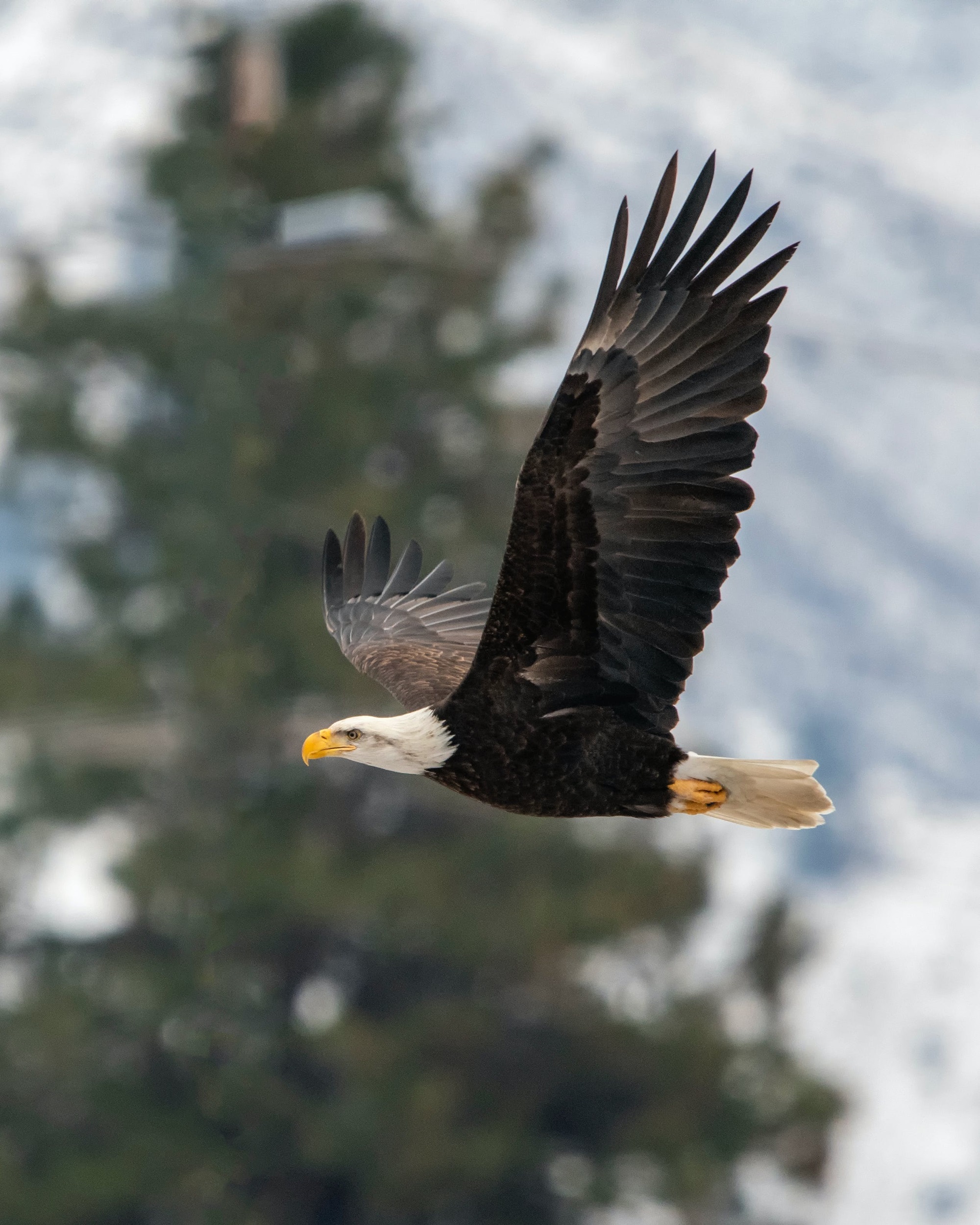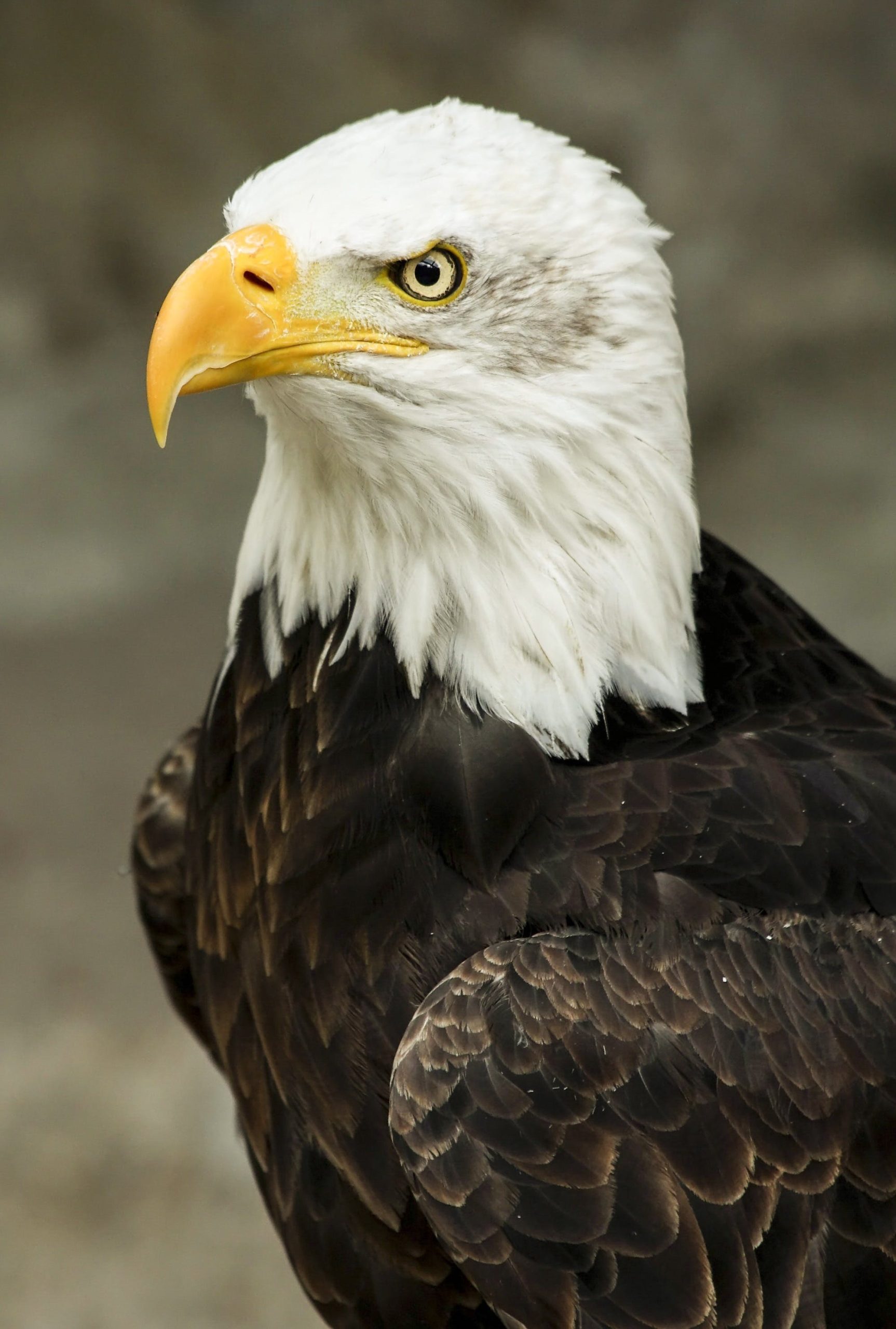Welcome to the Pet Breed Hub! Today, we’re soaring high with an exciting exploration of the Bald Eagle, a symbol of freedom and strength. Get ready for an engaging journey into the world of these majestic birds!
Features

- Scientific name: Haliaeetus leucocephalus
- Mass: 3 – 6.3 kg
- Speed: 120 – 160 km/h (Diving)
- Wingspan: Up to 7 feet!
- Weight: 6–14 pounds; females are larger than males.
- Color: iconic white head and tail, brown body.
Habitat Insights
- Where They Live: Primarily in North America.
- Nesting Areas: Near large bodies of open water.
Bald Eagle Size: A Fascinating Insight
Wingspan Wonders
Expansive Reach: Bald Eagles boast a wingspan ranging from 6 to 7 feet. This remarkable span is not just for show; it aids in their agile flight and precise hunting.
Weighty Matters
Mighty Mass: Adult Bald Eagles typically weigh between 6 to 14 pounds. Interestingly, females are usually larger than their male counterparts, a common trait in birds of prey.
Height Highlights
Towering Presence: From head to talon, these eagles can stand 3 to 3.5 feet tall. Their stature is a mix of dignified poise and predatory prowess.
Comparative Perspective
Human Comparison: When a Bald Eagle stretches its wings, it’s almost like a human stretching out their arms; the wingspan can be as wide as an average room.
In the Bird World: Among North American birds, their size is surpassed only by the California Condor and the White Pelican.
A Symbol of Might
The size of the Bald Eagle is not just a physical attribute; it’s a symbol of their strength, survival skills, and the freedom they represent as they soar through the skies.
Lifespan: A Glimpse into Their Longevity
Years of Majesty
In the Wild: Bald Eagles typically enjoy a lifespan ranging from 20 to 30 years in their natural habitat. This duration showcases their resilience and adaptability to environmental challenges.
Captivity: Under human care, where threats are minimized, these majestic birds can live even longer, sometimes exceeding 30 years.
Factors Influencing Longevity
Diet: A nutritious diet, mainly consisting of fish, contributes significantly to their health and longevity.
Natural Predators: Adult Bald Eagles have few natural predators, aiding in their longer life spans.
Human Impact: Conservation efforts have played a crucial role in enhancing their life expectancy, especially after facing threats from DDT pesticides in the past.
Significance
Ecosystem Role: Their long life allows them to play a vital role in their ecosystems for many years, acting as top predators that help maintain balance.
Symbolic Meaning: The Bald Eagle’s longevity adds to their symbolism of strength and endurance in American culture.
Fascinating Facts

Discover some captivating facts about the Bald Eagle, the majestic symbol of freedom and strength.
Not Bald: Despite their name, Bald Eagles aren’t bald. “Bald” is derived from an old word meaning “white,” referring to their distinctive white head and tail feathers.
Impressive Wingspan: These eagles boast an impressive wingspan of up to 7 feet, allowing them to glide effortlessly through the skies.
Predatory Prowess: Bald Eagles are skilled hunters with incredible vision. They can spot prey from high in the sky and swoop down at speeds of up to 100 mph to catch it.
Lifespan: In the wild, Bald Eagles can live up to 30 years, showcasing their resilience and adaptability.
Nesting Marvels: Their nests, known as ‘aeries,’ can reach sizes of up to 8 feet in diameter and 13 feet deep, making them among the largest of any bird species.
Pair Bonding: Mated Bald Eagles often return to the same nest year after year, continually adding to their size and strength.
Vocal Variety: Contrary to Hollywood depictions, their calls are often gentle and melodic, including whistles, chirps, and clicks.
Conservation Success: Thanks to conservation efforts and the banning of DDT pesticides, Bald Eagles have made a remarkable recovery and are no longer endangered.
Top of the Food Chain: Adult Bald Eagles have few natural predators, reflecting their status as top predators in their ecosystems.
Symbol of Freedom: The Bald Eagle is the national bird and symbol of the United States, representing freedom and power.
Bald Eagle Nests: Engineering Marvels in the Sky
Nest Construction: A Labor of Love
Size and Structure: Bald Eagle nests, known as ‘aeries,’ are among the largest of any bird species. They can reach up to 8 feet in diameter and 13 feet deep, weighing nearly a ton.
Building Materials: These nests are crafted from sticks and lined with softer materials like grass, moss, or even feathers.
Location: Typically found high in large, sturdy trees near water bodies, these nests offer safety and proximity to food sources.
A Lifelong Project
Continual Expansion: Bald Eagles return to the same nest year after year, continually adding materials. This results in the nests becoming massive over time.
Shared Effort: Both the male and female participate in nest building, strengthening their pair bond.
Nesting Cycle
Egg Laying: The female usually lays 1 to 3 eggs annually.
Incubation: Both parents share the responsibility of incubating the eggs for about 35 days.
Rearing Chicks: Eaglets stay in the nest for about 10–12 weeks before their first flight.
Significance
Indicator of Health: The condition and continual use of these nests reflect the health of the local eagle population and their habitat.
Conservation Efforts: Protecting nesting areas is crucial for the conservation of bald eagles.
Bald Eagle Sounds: The Voice of the Sky
Eagle Vocalizations: Beyond Expectations
Common Sounds: Contrary to their fierce appearance, Bald Eagles often emit surprisingly gentle and high-pitched sounds, including whistles, chirps, and clicks.
Purpose of Calls: These vocalizations serve various purposes, such as communication between mates, signaling distress, or establishing territory.
Misconceptions
Hollywood Myth: Many people expect a Bald Eagle’s cry to be a bold, powerful scream due to common sound effects used in movies. In reality, their calls are less intimidating and more melodic.
Listening to Nature
Observation Tip: To truly appreciate the unique sounds of the Bald Eagle, it’s best to listen to them in their natural habitat, where their calls echo across the skies.
FAQs
1: Where can I find Bald Eagles in the wild?
Bald Eagles are primarily found in North America, particularly near large bodies of open water like lakes, rivers, and coastal areas.
2: What do Bald Eagles eat?
Their primary diet consists of fish, but they are opportunistic feeders and may also consume birds, mammals, and carrion.
3: Do Bald Eagles migrate?
Some Bald Eagles migrate depending on their geographic location. Those in colder northern regions may migrate to warmer areas in the winter.
4: Why are they called “Bald Eagles”?
The term “bald” comes from an old word meaning “white,” referring to their distinctive white head and tail feathers.
5: How fast can a Bald Eagle fly?
Bald Eagles can reach speeds of up to 100 miles per hour in a dive while hunting.
6: Are Bald Eagles solitary birds?
They are mostly solitary, except during the breeding season when they form pairs.
7: What sounds do Bald Eagles make?
They produce a variety of sounds, including high-pitched whistles, chirps, and clicks. Their calls serve various purposes, from communication to territory establishment.
8: Can Bald Eagles swim?
Yes, Bald Eagles are strong swimmers and are known to swim when necessary, especially after catching fish.
9: Are Bald Eagles still endangered?
No, Bald Eagles are no longer considered endangered. Conservation efforts, including the banning of DDT pesticide, have led to their recovery, and they are now protected.
10: Why are Bald Eagles the national bird and symbol of the United States?
Bald Eagles represent freedom and power, making them a fitting symbol for the United States. They were chosen as the national bird in 1782 due to their majestic appearance and significance.
Conclusion
The Bald Eagle, with its majestic wings and fierce demeanor, remains a fascinating and vital part of our natural world. Their journey from the brink of extinction to a thriving species is a testament to effective conservation efforts.
References And External Links
National Audubon Society: The Audubon Society provides comprehensive information on birds, including Bald Eagles.
U.S. Fish and Wildlife Service: The federal agency responsible for the protection and conservation of Bald Eagles in the United States.
National Park Service: Many national parks in the United States are home to Bald Eagles, and their websites often provide information about local wildlife.
BirdLife International: An international organization dedicated to bird conservation, with information on Bald Eagles and other bird species.

